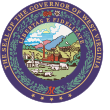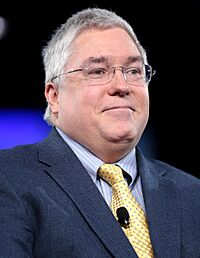List of governors of West Virginia facts for kids
Quick facts for kids Governor of West Virginia |
|
|---|---|

Seal of the governor
|
|
| Style |
|
| Residence | West Virginia Governor's Mansion |
| Term length | Four years, renewable once consecutively |
| Inaugural holder | Arthur I. Boreman |
| Formation | June 20, 1863 |
| Succession | Line of succession |
| Salary | $150,000 (2022) |
The governor of West Virginia is the main leader of the state's government. They are also the commander-in-chief of West Virginia's military forces, like the West Virginia National Guard. The governor's job is to make sure state laws are followed. They can approve or reject new laws passed by the West Virginia Legislature. The governor can also call the legislature together at any time. They have the power to grant pardons (forgive someone for a crime) or reprieves (delay a punishment).
West Virginia became a state on June 20, 1863, during the American Civil War. Since then, 37 people have served as governor. Two governors, Arch A. Moore Jr. and Cecil H. Underwood, served two terms that were not back-to-back. The governor who served the longest was Arch A. Moore Jr., for a total of twelve years over three terms.
The first governor of West Virginia was Arthur I. Boreman. He served the most terms in a row, but he resigned a week before his third term ended. Before West Virginia became a state, Francis Harrison Pierpont was chosen as governor in 1861. He is known as the "Father of West Virginia."
Daniel D. T. Farnsworth was the shortest-serving governor. He was the senate president and filled the last seven days of Governor Boreman's term. Cecil H. Underwood holds a special record. He was the youngest person elected governor at age 34 in 1957. He was also the oldest person elected and serving as governor at age 74 in 1997. The current governor is Republican Patrick Morrisey, who started his term on January 13, 2025.
To become governor, a person must be at least 30 years old. They must also have lived in West Virginia for at least five years before becoming governor. The state's current constitution, which was approved in 1872, says the governor serves for four years. Their term starts on the Monday after the second Wednesday in January, right after an election. The first constitution in 1863 only allowed for a two-year term. Since 1968, a governor can be reelected many times, but not more than twice in a row. If someone serves part of a term, it counts towards this two-term limit.
West Virginia's constitution does not mention a lieutenant governor. If the governor's position becomes empty, the senate president is next in line to take over. If there is more than one year left in the governor's term, a new election is held to choose a governor for the rest of the term. If there is less than a year left, the senate president acts as governor for the remaining time. A law passed in 2000 gives the senate president the honorary title of lieutenant governor. However, this title is not often used. After the senate president, the next in line are the speaker of the West Virginia House of Delegates, then the state attorney general, the state auditor, and then former governors who live in the state.
Who Can Be Governor?
To be elected Governor of West Virginia, a person must meet these requirements:
- Be a citizen of the United States.
- Have lived in West Virginia for at least five years before the election.
- Be a qualified voter in West Virginia.
- Be at least 30 years old.
West Virginia Governors List
| No. | Governor | Term in office | Party | Election | ||
|---|---|---|---|---|---|---|
| 1 |  |
Arthur I. Boreman (1823–1896) |
June 20, 1863 – February 26, 1869 (resigned) |
Republican | 1863 | |
| 1864 | ||||||
| 1866 | ||||||
| 2 |  |
Daniel D. T. Farnsworth (1819–1892) |
February 26, 1869 – March 4, 1869 (successor took office) |
Republican | President of the Senate acting |
|
| 3 |  |
William E. Stevenson (1820–1883) |
March 4, 1869 – March 4, 1871 (lost election) |
Republican | 1868 | |
| 4 |  |
John J. Jacob (1829–1893) |
March 4, 1871 – March 4, 1877 (term-limited) |
Democratic | 1870 | |
| People's Independent |
1872 | |||||
| 5 |  |
Henry M. Mathews (1834–1884) |
March 4, 1877 – March 4, 1881 (term-limited) |
Democratic | 1876 | |
| 6 |  |
Jacob B. Jackson (1829–1893) |
March 4, 1881 – March 4, 1885 (term-limited) |
Democratic | 1880 | |
| 7 |  |
Emanuel Willis Wilson (1844–1905) |
March 4, 1885 – February 6, 1890 (term-limited) |
Democratic | 1884 | |
| 8 |  |
Aretas B. Fleming (1839–1923) |
February 6, 1890 – March 4, 1893 (term-limited) |
Democratic | 1888 | |
| 9 |  |
William A. MacCorkle (1857–1930) |
March 4, 1893 – March 4, 1897 (term-limited) |
Democratic | 1892 | |
| 10 |  |
George W. Atkinson (1845–1925) |
March 4, 1897 – March 4, 1901 (term-limited) |
Republican | 1896 | |
| 11 |  |
Albert B. White (1856–1941) |
March 4, 1901 – March 4, 1905 (term-limited) |
Republican | 1900 | |
| 12 |  |
William M. O. Dawson (1853–1916) |
March 4, 1905 – March 4, 1909 (term-limited) |
Republican | 1904 | |
| 13 |  |
William E. Glasscock (1862–1925) |
March 4, 1909 – March 4, 1913 (term-limited) |
Republican | 1908 | |
| 14 |  |
Henry D. Hatfield (1875–1962) |
March 4, 1913 – March 4, 1917 (term-limited) |
Republican | 1912 | |
| 15 |  |
John J. Cornwell (1867–1953) |
March 4, 1917 – March 4, 1921 (term-limited) |
Democratic | 1916 | |
| 16 |  |
Ephraim F. Morgan (1869–1950) |
March 4, 1921 – March 4, 1925 (term-limited) |
Republican | 1920 | |
| 17 |  |
Howard Mason Gore (1877–1947) |
March 4, 1925 – March 4, 1929 (term-limited) |
Republican | 1924 | |
| 18 |  |
William G. Conley (1866–1940) |
March 4, 1929 – March 4, 1933 (term-limited) |
Republican | 1928 | |
| 19 |  |
Herman G. Kump (1877–1962) |
March 4, 1933 – January 18, 1937 (term-limited) |
Democratic | 1932 | |
| 20 |  |
Homer A. Holt (1898–1975) |
January 18, 1937 – January 13, 1941 (term-limited) |
Democratic | 1936 | |
| 21 |  |
Matthew M. Neely (1874–1958) |
January 13, 1941 – January 15, 1945 (term-limited) |
Democratic | 1940 | |
| 22 |  |
Clarence W. Meadows (1904–1961) |
January 15, 1945 – January 17, 1949 (term-limited) |
Democratic | 1944 | |
| 23 |  |
Okey Patteson (1898–1989) |
January 17, 1949 – January 19, 1953 (term-limited) |
Democratic | 1948 | |
| 24 |  |
William C. Marland (1918–1965) |
January 19, 1953 – January 14, 1957 (term-limited) |
Democratic | 1952 | |
| 25 |  |
Cecil H. Underwood (1922–2008) |
January 14, 1957 – January 16, 1961 (term-limited) |
Republican | 1956 | |
| 26 |  |
Wally Barron (1911–2002) |
January 16, 1961 – January 18, 1965 (term-limited) |
Democratic | 1960 | |
| 27 |  |
Hulett C. Smith (1918–2012) |
January 18, 1965 – January 13, 1969 (term-limited) |
Democratic | 1964 | |
| 28 |  |
Arch A. Moore Jr. (1923–2015) |
January 13, 1969 – January 17, 1977 (term-limited) |
Republican | 1968 | |
| 1972 | ||||||
| 29 |  |
Jay Rockefeller (b. 1937) |
January 17, 1977 – January 14, 1985 (term-limited) |
Democratic | 1976 | |
| 1980 | ||||||
| 30 |  |
Arch A. Moore Jr. (1923–2015) |
January 14, 1985 – January 16, 1989 (lost election) |
Republican | 1984 | |
| 31 |  |
Gaston Caperton (b. 1940) |
January 16, 1989 – January 13, 1997 (term-limited) |
Democratic | 1988 | |
| 1992 | ||||||
| 32 |  |
Cecil H. Underwood (1922–2008) |
January 13, 1997 – January 15, 2001 (lost election) |
Republican | 1996 | |
| 33 |  |
Bob Wise (b. 1948) |
January 15, 2001 – January 17, 2005 (did not run) |
Democratic | 2000 | |
| 34 |  |
Joe Manchin (b. 1947) |
January 17, 2005 – November 15, 2010 (resigned) |
Democratic | 2004 | |
| 2008 | ||||||
| 35 |  |
Earl Ray Tomblin (b. 1952) |
November 15, 2010 – January 16, 2017 (term-limited) |
Democratic | President of the Senate acting |
|
| 2011 (special) |
||||||
| 2012 | ||||||
| 36 |  |
Jim Justice (b. 1951) |
January 16, 2017 – January 13, 2025 (term-limited) |
Democratic | 2016 | |
| Republican | 2020 | |||||
| 37 |  |
Patrick Morrisey (b. 1967) |
January 13, 2025 – Incumbent |
Republican | 2024 | |
Timeline of Governors
| Timeline of West Virginia governors |
 |
See Also
- Gubernatorial lines of succession in the United States § West Virginia
- List of West Virginia state legislatures


